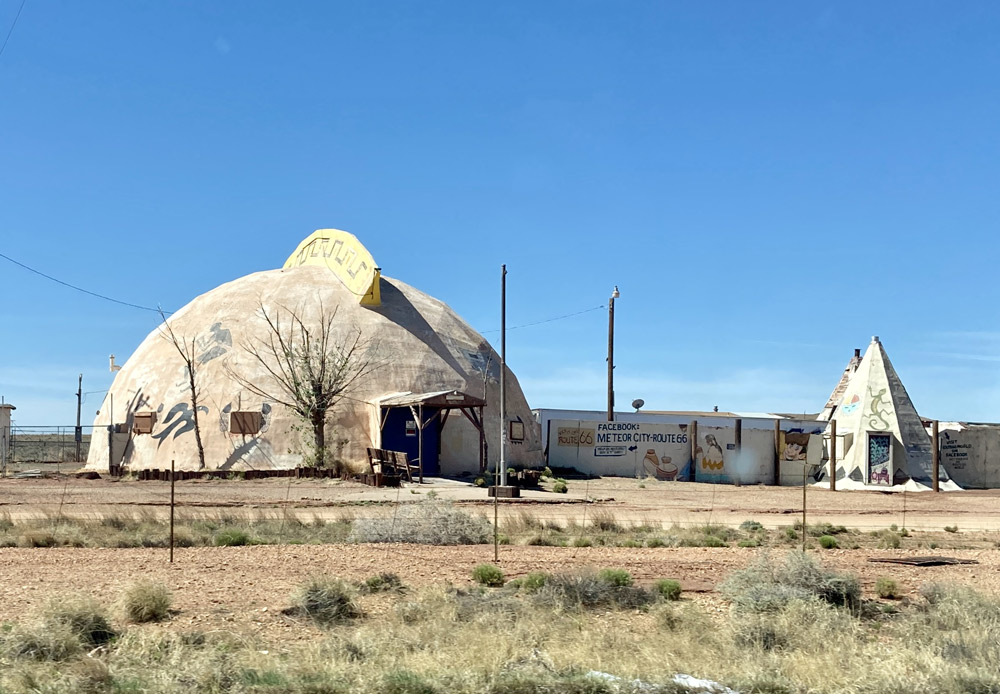
Travel

From her Roswell, New Mexico base, Jess Johnson has been exploring the American Southwest, including Meteor City Trading Post in bordering Arizona.
Perpetual Motion Machine
Jess Johnson experiences UFO culture, desert fauna and lots of stray cats on an artist residency in Roswell, New Mexico.
By Jess Johnson
“Artist residencies” are possibly an unfamiliar career quirk to anyone not entrenched in art-world terminology. For the last dozen years, I’ve been in motion between them. Yearly, I apply to arts organisations who host artists at their facilities. The ones I am accepted into determine where I will be located for a time. It’s akin to throwing mud at a wall and seeing what sticks. The residencies often provide large, light-filled studios that I couldn’t afford otherwise, small stipends to live on, workshop facilities, and organisational support. I am adept at distilling my life and pens into a suitcase and landing in a strange new place knowing no one. “Home” is a loose term. I maintain a spartan apartment, which I sublet out to strangers while I spend most of my time elsewhere. My mental home remains wherever my parents are, which is admittedly a rather adolescent thing for a 43-year-old woman to say.
This year, I am living in Roswell, New Mexico, in the US Southwest. Roswell is perhaps best known for being the place a crashed UFO was reportedly recovered by army personnel in 1947. The military, after first announcing a flying disc crash, quickly revised their story, saying it was in fact an experimental weather balloon. Cover-up or not, Roswell remains a beacon for ufologists. The fact that I ended up in Roswell comes as no surprise to anyone familiar with the alien demigods and cryptic symbology in my artwork.
Roswell itself is a dusty desert town of around 48,000, surviving on a trickle of alien-related tourism and the income of remote oil workers. Situated in the high plains of the Chihuahuan Desert, the town is three hours from anywhere. The nearest cities are El Paso on the Mexican border, and Albuquerque, of Breaking Bad fame.
I arrived in May to begin my 365 days at the residency compound. Established in 1967 by a local oil man and artist, the Roswell Artist-in-Residence programme is called “the Gift of Time”. Uniquely, it offers artists a full year to concentrate solely on their art. Artists are encouraged to bring family, pets, all their worldly possessions, and stay forever if the vibe takes them. Some do. The small town is sprinkled with alumni seduced by the desert skies and cheap cost of living, who bought derelict factories for what a carpark would cost in New York, and proceeded to build rambling eccentric playgrounds from their dreams.
The current residents live on a purpose-built compound on the outskirts of town. Six artists are chosen every year, each provided with a three bedroom house and large studio. There are also woodworking, ceramic and metalworking facilities. We’re given a stipend to live on, then left to our own devices. The compound atmosphere is laconic and comfortably dishevelled. Residency director Larry Bob lives on-site with his family and geriatric dog. Surrounded by scrubby desert, the residents’ many pets and children roam free. Communal grill-outs and gatherings happen in the central common area, a large covered space littered with children’s toys, rotting ping-pong tables and a motley assortment of chairs. One of the first things to jar new residents is discovering there is no recycling in Roswell. Hardliners initially attempt to stockpile their recyclables, intending to drive it to the nearest city to sort. This usually lasts a month before the resident gives up and throws their cans into the communal skip. Giving up is called “going full Roswell”.
Local friendships are made and passed on through the residents. There is Spider, a gangly 60-something cowboy with a moustache to rival Sam Elliott’s. He tips his hat, makes his own boots, and always dresses up in his finest to visit, bringing presents of old horseshoes and cow skulls, believing we will make something beautiful from them. There is Laura the egg lady, who runs the local auto-transmission shop, which she inherited from her father, although the locals are slow to accept a woman working on their trucks so she sells eggs on the side. There is Cat, a geologist working for the oil companies who cares for a large colony of abandoned cats living in the Walmart carpark. We help each other with our “cat activities”.
